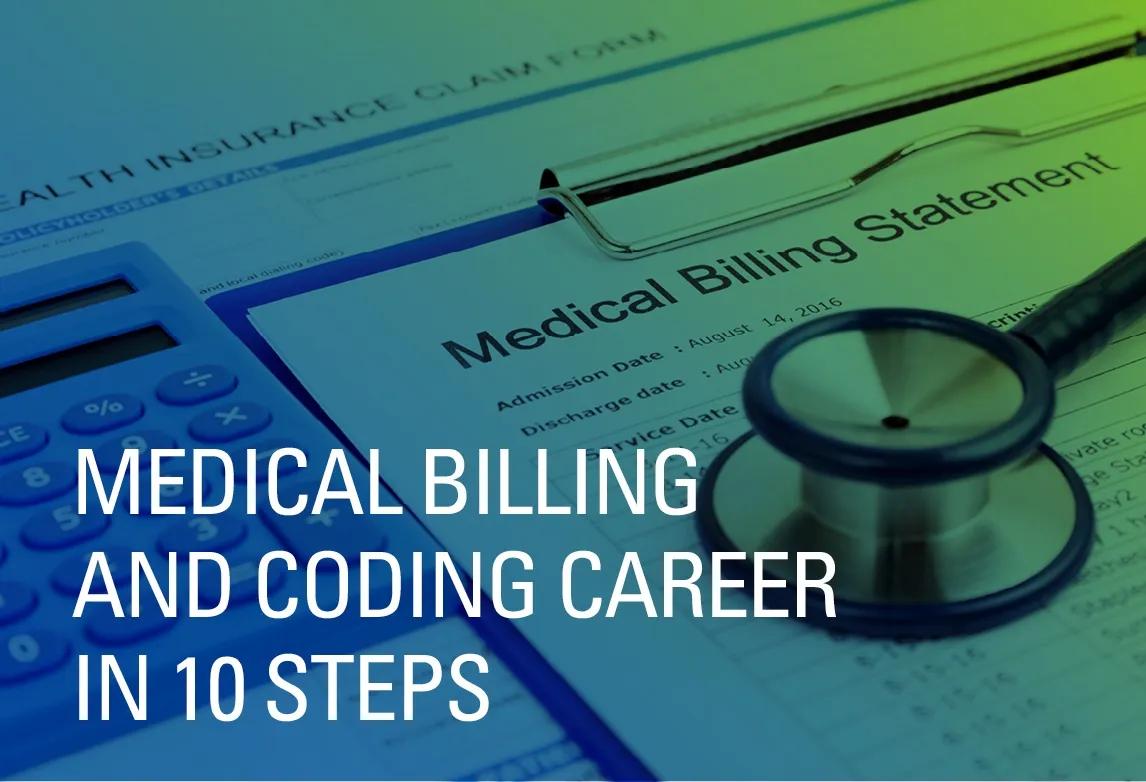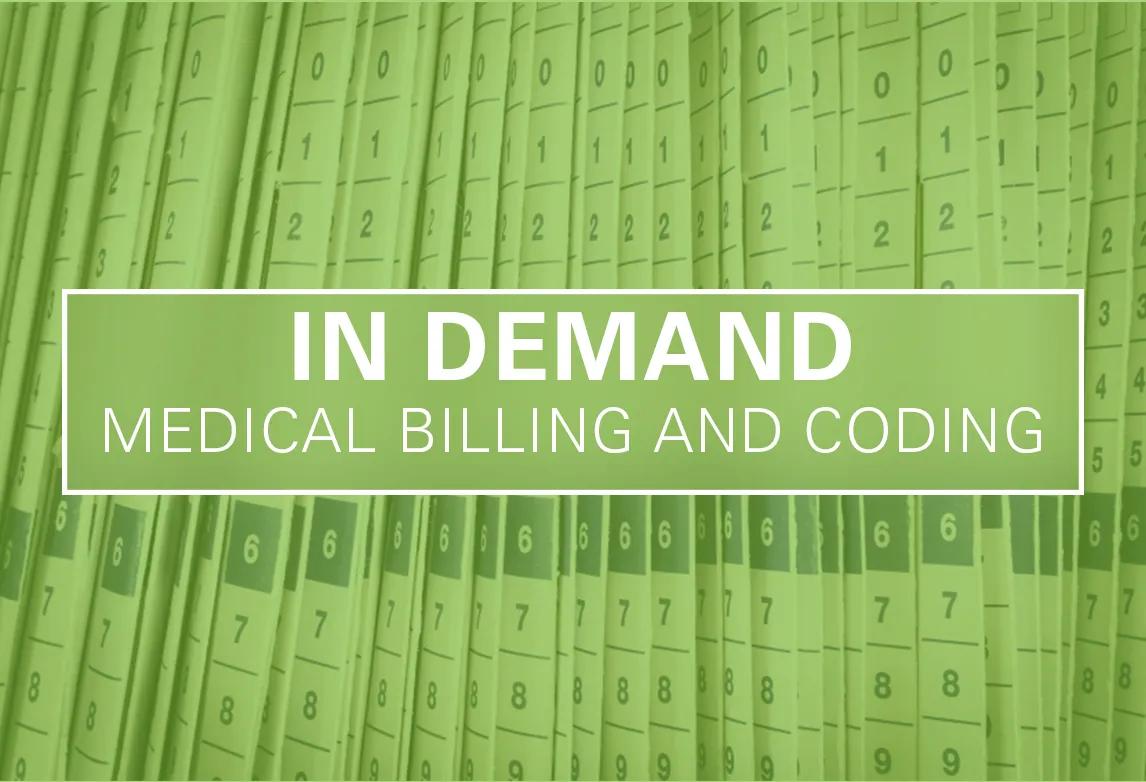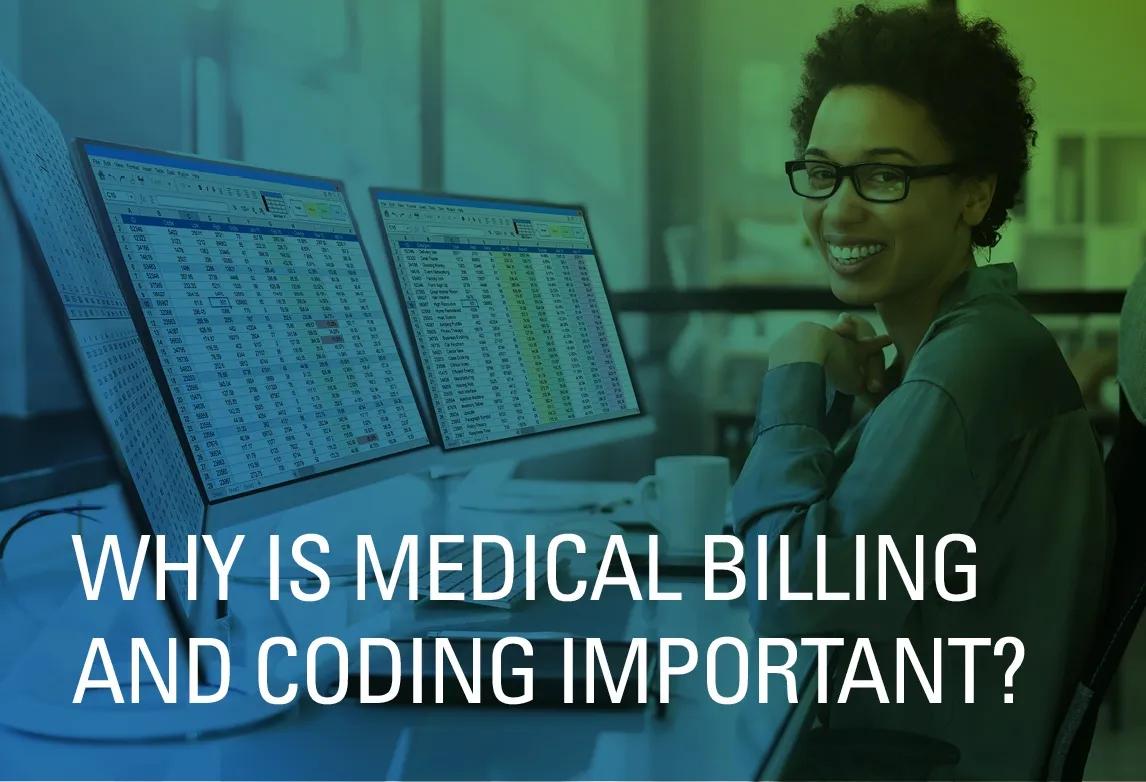Medical Billing and Coding Career in 10 Steps

Are you considering a medical billing and coding career? If you’re detail-oriented and have an investigative mind, this profession could be a good fit for you.
Learn more about this in-demand field and how medical billing and coding courses can help you get your start. From reading up on the role to completing your education and certification to finding the right job, we’ve outlined 10 steps to help you kick off your medical billing and coding career.
Follow the 10 Steps to Start a Medical Billing and Coding Career:
Step 1: Discover what a medical billing and coding career is all about.
Medical billing and coding specialists help healthcare providers run their practices more efficiently. They do this by coding claims and processing in a timely manner.
As the name implies, there are two key components to this work: 1) applying codes to healthcare diagnoses and treatments; and 2) billing insurers, patients, and other payers for medical services.
What is medical coding?
Medical codes simplify communication between healthcare providers, insurers, and other agencies by using universal identifiers for every diagnosis, illness, injury, procedure, and treatment. Coding specialists must have a basic understanding of medical terminology so they can apply the correct codes when entering the data into a computer.
Coders rely on several sources for the numeric and alphanumeric codes used in this field. The International Classification of Diseases (ICD) assigns standard codes to illnesses and injuries, while Current Procedure Terminology (CPT) and the Healthcare Common Procedure Coding System (HCPCS) identify the services and treatment provided. Once coding is completed, the next step is billing.
What do medical billers do day-to-day?
Medical billing professionals prepare and send invoices, or claims, for payment. After confirming all aspects of an office visit or hospital admission have been properly coded, they submit the claim to an insurance company, Medicare, Medicaid, or other payer.
If the claim is rejected, they will apply any necessary corrections and resubmit it. Once the insurance provider has paid the allowable amount for covered services, the medical biller may send an invoice to the patient for any balance due.
Step 2: Research medical billing and coding education options.
If a medical billing and coding career sounds like the right fit for you, the next step is to determine how you’ll obtain the necessary training. You have many options to choose from, so you’ll want to do your research to find reputable programs with a track record of employed graduates.
You might begin by looking at schools in your local area. Which schools are within a reasonable commuting distance? Do they offer classes that suit your schedule?
Alternately, online courses can be an excellent option if you’re seeking greater flexibility.
Online medical billing and coding courses make it easier to balance classes with work, family, and personal obligations. They allow you to study at your own pace and on your own schedule, within instructor-led deadlines, and connect with your instructors and fellow students in a supportive learning environment.
Online education is best for self-motivated students since it requires follow-through and dedication. You may also be able to find an online school that supports you and works with you every step of the way, so you don’t feel alone.
Step 3: Find the right school.
When choosing a medical billing and coding program, it’s important to select a reputable school that will help you position yourself for success. Here are a few key questions to consider:
- Is the school accredited?
Look for a school that is recognized by a relevant accrediting body such as the Accrediting Bureau of Health Education Schools (ABHES.org). - What kind of financial aid is available?
If you plan to seek financial assistance to help pay for tuition, check to see if the school you’re considering will help coordinate Federal Student Aid, Veteran’s Benefits, employer tuition reimbursement, or other forms of financial support if qualified. - Does the school prepare students for industry certification?
Many employers prefer to hire job applicants with relevant certification, such as the Certified Professional Coder (CPC®) credential from AAPC. - Does the school provide career services and job support?
Make sure your school offers ongoing support after graduation to help you launch your medical billing and coding career and prepare for advancement.
Step 4: Choose a diploma or degree program.
Once you’ve settled on a school, you may have a choice of programs. For example, Ultimate Medical Academy offers two medical billing and coding programs: a diploma or an associate degree.
Medical Billing and Coding Diploma
With 39 semester credits, UMA’s Medical Billing and Coding Diploma may be completed in as little as 11 months depending on the individual student. You’ll receive industry-relevant training via online courses and learn from dedicated instructors who are committed to your success. This program focuses on practical skills that are in demand by a variety of healthcare organizations.
Associate Degree in Medical Billing and Coding
If you’re willing to invest more time in your education, you may wish to consider an associate degree in Medical Billing and Coding.
UMA’s online degree program builds on the core courses featured in the diploma curriculum while adding general education subjects.
In total, you’ll complete 20 courses and 63 semester credits, and can earn your degree in as little as 18 months depending on the individual student.
Step 5. Complete relevant medical billing and coding courses.
Whether you choose UMA’s diploma or degree programs, you’ll receive a well-rounded foundation in all of the key knowledge areas required for entry-level opportunities in medical billing and coding. Among the topics you’ll study are:
- Diagnostic Coding
- Procedural Coding
- Billing and Coding Applications
- Healthcare Communication
- Medical Terminology
- Medical Law, Ethics, and Records Management
- Healthcare Settings, Claim Cycle, and Claims Processing
- Anatomy, Physiology, and Pathophysiology
Step 6: Prepare for the CPC certification exam.
Upon completing UMA’s diploma or associate program, you’ll be prepared to take the Certified Professional Coder examination offered by the AAPC. While certification is not always required to work in medical billing and coding, many employers list CPC as a preferred or required job qualification.
Earning your CPC credential can help position you as a preferred candidate for entry-level job opportunities in the allied healthcare field.
Step 7: Leverage career resources to prepare for your job search.
Once you’ve graduated with a medical billing and coding diploma or degree, UMA Career Services is ready to help you target employment opportunities and pursue your career goals.
Whether you need help creating a resume, writing a cover letter, or practicing your interviewing skills, your student success team can assist.
UMA has relationships with thousands of employers nationwide — giving you access to a wide array of job opportunities — and even provides (at no additional charge) continuing education through its Tools for Alumni Professional Success (TAPS) program.
Step 8: Explore medical billing and coding jobs.
If you’d like to learn what types of medical billing and coding jobs are available in your area, a quick internet search can help you find out which companies are hiring and the kinds of positions they’re seeking to fill.
Review medical billing and coding job descriptions.
If you’re wondering what employers look for in a job candidate, you may find it helpful to skim through some entry-level job postings. The following are some of the work responsibilities commonly listed in medical billing and coding job descriptions:
- Translate medical terminology into corresponding ICD, CPT, and HCPCS codes.
- Enter codes into industry-specific computer software programs.
- Process healthcare claims and perform accounts receivable (AR) functions.
- Ensure claims contain the information required for timely reimbursement.
- Review rejected claims, correct as needed, and resubmit or appeal.
- Submit patient statements on a routine, scheduled basis.
- Maintain high billing standards that adhere to current industry guidelines.
Learn how to find medical billing and coding jobs now!
The simplest way to get started is to run a Google search for “medical billing and coding jobs.” Google pulls results from a variety of job sites, and typically displays listings in your local area. You can specify a city in the search box if the results don’t default to your current location, or if you’re planning to relocate elsewhere.
You can also conduct your search directly on job sites such as Indeed, CareerBuilder, Monster, or on career networking sites such as LinkedIn.
The advantage of using job-search or networking sites is that they typically allow you to create and save a resume so you can apply for jobs directly through their website.
In addition, you can set up alerts that will email you when there are new jobs matching your search criteria. The more sites you’re registered with, the more chances you’ll have to discover new job opportunities.
Step 9: Tap into referrals, recommendations, and networking.
Enrolling in a medical billing and coding program is a great way to meet others in your prospective career field. Many companies offer bonuses to employees who refer qualified candidates so your classmates may be happy to recommend you if they land a job somewhere you’d like to work. You can also ask your instructors to serve as references and submit a publicly visible recommendation on LinkedIn.
As a UMA graduate, you can take advantage of the ConnectUMA private networking platform which includes an alumni directory, job board, mentorship opportunities, and much more.
Step 10: Begin your medical billing and coding career!
The medical billing and coding field has openings for qualified professionals with relevant skills, knowledge, and experience.
How to get experience in medical billing and coding
Some healthcare agencies require that applicants have some level of experience before applying. One way to gain the required experience is to do an internship. This provides on the job training and can either be paid or unpaid.
Another way to gain experience as a medical biller and coder is to start in a clerical position and work your way into a billing and coding role. While this may not be ideal, it is one way to enter this field when you don’t have the needed experience.
Otherwise, the best way to show that you can fulfill medical billing and coding duties is to earn your diploma or degree. UMA is a great place to obtain your training and education for a number of reasons:
- Convenient online courses
- Choice of diploma or associate degree programs
- Accepts Federal Student Aid, Veteran’s Benefits, employer tuition reimbursement, and other forms of financial assistance for those who qualify
- Prepares students for the CPC exam
- Offers career services, networking opportunities, and other resources
Ready to get started on pursuing your medical billing and coding career? Contact us now to discuss your options and visit the Medical Billing and Coding program page!
FAQs
How much does a medical coder and biller make?
The Bureau of Labor Statistics reports that the median annual salary in 2020 for medical records and health information technician roles earned $45,240 or $21.75 per hour. Actual salary varies based on education, experience, geographical location, and more.
Which certification is best for medical billing and coding?
Medical billers and coders can earn a number of different certifications. These include Certified Professional Coder (CPC) Certified Coding Specialist (CCS). Which is best depends, in part, on your goals as a biller and coder. For example, if you’d like to work for an outpatient facility such as a physician’s office, a CPC certification may be best, whereas a CCS certification may be preferred by an inpatient healthcare provider such as a hospital. Some employers require both certifications to work as a medical biller and coder.
How long does it take to become a medical biller and coder?
Ultimate Medical Academy’s Medical Billing and Coding diploma program can be completed in as little as 11 months. Our degree program takes approximately 18 months to complete, though some students take a bit longer.
How do I become a medical biller and coder from home?
One benefit of Ultimate Medical Academy’s Medical Billing and Coding diploma and degree programs is that they are offered online. This enables you to earn your diploma or degree from home, work, or any other convenient location. If you’d like to learn more about how to study to become a medical biller and coder from home, contact us today!
Request Information
Talk with us. Start your journey.
Complete this form and we'll call you to explore options at UMA and answer your questions. We'll also email you info on how to get started. We're with you at every step!
Request Information
Talk with us. Start your journey.
Complete this form and we'll call you to explore options at UMA and answer your questions. We'll also email you info on how to get started. We're with you at every step!
About the Author
 Adam Fenster
Adam FensterAdam Fenster is a senior copywriter at Ultimate Medical Academy, with journalism experience from his time as a reporter and editor for multiple online and print publications. Adam has been covering healthcare education since 2019, with an emphasis on topics such as wellness, healthcare employment, and job preparedness. He received his BA in journalism from the University of South Florida.
Related Content


